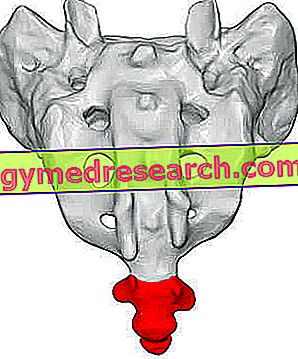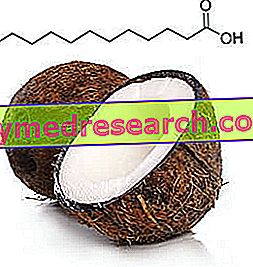Generality
The coccyx is the uneven bone structure, generally composed of 4 vertebrae, which constitutes the last tract of the spine.
Triangular in shape and situated below the sacrum, the coccyx is the last testimony of the tail present in our ancestors, in very remote times.
From the anatomical point of view, it presents at least 6 regions of a certain relevance: the base of the coccyx, the apex of the coccyx, the front surface, the posterior surface and the two lateral surfaces.

Coccyx (in red): Rear view. Image from wikipedia.org
The coccyx participates in only one joint: the sacro-coccygeal joint, which - as it is easy to understand - joins the sacrum to the base of the coccyx.
Among its functions, they include: protecting the terminal portion of the bone marrow, supporting the weight of the body in a sitting position and, finally, inserting muscles (eg: large gluteus and elevator of the anus), ligaments, tendons, etc.
What is the coccyx?
The coccyx is the terminal part of the spine . To be precise, it is the set of vertebrae, forming a triangle-shaped structure, which resides below the sacrum .
ANATOMICAL BRIEF REVIEW OF THE VERTEBRAL COLUMN
Supporting axis of the human body, the vertebral column or spine is a bone structure of about 70 centimeters (in the adult human being), which includes 33-34 vertebrae stacked on each other.
The vertebrae of the spine have a general structure quite similar to each other. In fact, they all have:
- A body (anteriorly);
- An arch similar to a horseshoe (posteriorly);
- A vertebral hole, deriving from the union of the arch to the body.
The vertebral holes of each vertebra coincide and this determines the formation of a long canal - the so-called spinal canal or vertebral canal - which serves to house the spinal cord .
The spinal cord is, together with the brain, one of the two elements that make up the central nervous system ( CNS ).
Anatomy
The coccyx is an unequal and symmetrical bone structure, derived essentially from the superposition of the coccygeal vertebrae .
In most humans, the coccygeal vertebrae are 4; more rarely, they are 3, 5 or 6.
Their size is decreasing from top to bottom: this means that the first coccygeal vertebra is the largest, while the last is the smallest.
The first coccygeal vertebra has two notable transverse processes; all the coccygeal vertebrae lack peduncles, laminae and spinous processes.
As a rule, the vertebral elements of the coccyx undergo a process of fusion, which begins in adulthood and ends within a few years.
In describing the coccyx, the anatomists identify in the latter at least 6 regions of a certain relevance: the base of the coccyx, the apex of the coccyx, the front surface, the posterior surface and the two lateral surfaces.
- Base of coccyx : it is the flat portion, located in the upper part of the coccyx and representing the junction point with the sacrum. Here, in fact, lies a plane space, a sort of "facet", which serves to articulate the first coccygeal vertebra with the last sacral vertebra.
The base of the coccyx also includes two particular prominences, called coccyx horns. The horns of the coccyx are the articular processes of the first coccygeal vertebra; oriented upwards, they make contact with the horns of the sacred, located on the dorsal surface of the latter and oriented downwards;
- Apex of coccyx : it is the inferior portion of the coccyx, the one that coincides with the last coccygeal vertebra and the end of the vertebral column. It has a rounded shape.
On the tip of the coccyx, the tendon of the external anal sphincter muscle is hooked;
- Anterior surface (or ventral surface) : slightly concave, it is the surface of the coccyx that looks towards the inside of the body. It has three characteristic transverse grooves and attaches to the sacro-coccygeal ligament and tendon of the levator ani.
- Posterior surface (or dorsal surface) : moderately convex, it is the surface of the coccyx that looks posteriorly, therefore in opposite sense to the front surface. It has three characteristic transverse grooves - just like the front surface - and the sketches of the articular processes of the coccygeal vertebrae.
- Side surfaces : the sides of the coccyx are rather thin. In correspondence of each vertebral element, they have bony eminences, which are the so-called transverse processes of the coccygeal vertebrae. The transverse processes are being reduced, in terms of size, from top to bottom: as stated, in the first coccygeal vertebra they are very evident; in the subsequent vertebral elements, they are decreasing.
JOINTS
The coccyx takes part in a joint : the so - called sacro-coccygeal articulation (or symphysis sacro-coccygeal ).
The sacro-coccygeal joint represents the point of contact between the last sacral vertebra and the first vertebra of the coccyx.
On the articular "facet", which resides at the base of the coccyx and forms the so-called sacro-coccygeal joint, there is a layer of fibrous cartilage .
The sacro-coccygeal joint is a little moving and passive joint element: it allows, in fact, minimal extension and flexion movements of the coccyx, with respect to the sacrum, during particular moments such as defecation or labor.

LIGAMENTS
The ligaments that establish relations with the coccyx are:
- The anterior sacro-coccygeal ligament: it is in fact the continuation of the anterior longitudinal ligament of the spine. It serves to connect the front faces of the vertebral bodies of the coccygeal vertebrae;
- The deep posterior sacro-coccygeal ligament: it is the ligament that connects the posterior side of the fifth sacral vertebra with the dorsal surface of the coccyx;
- The superficial posterior sacro-coccygeal ligament: it is the ligament that connects the median sacral crest (on the sacrum) to the posterior surface of the coccyx;
- The lateral sacoccoccygeal ligaments: they are the ligaments that run from the lateral surfaces of the sacrum to the transverse processes of the first coccygeal vertebra;
- The inter-articular ligaments: they are the ligaments that connect the horns of the sacrum with the horns of the coccyx.
MUSCLES
The coccyx gives insertion to one of the heads of origin of the large gluteal muscle and to one of the terminal heads of the levator ani muscle.
Origin and insertion | Functions | |
Large gluteal muscle | It has numerous heads of origin, including:
It ends on the gluteal tuberosity of the femur. | It allows:
|
Lifting muscle of the anus | It has 3 heads of origin:
Ends on the anterior surface of the coccyx. | It has supportive functions towards the viscera of the pelvic cavity. |
Development
In the embryo, the coccyx derives from a structure called the caudal eminence . Its formation occurs approximately between the fourth or eighth week of gestation. As the embryonic development continues, the caudal eminence regresses, but the coccyx remains.
Immediately after the formation of the coccyx, the vertebrae of the latter are separated and remain so for all the first years of life.
As stated, fusion of coccygeal vertebrae is a process that takes place during adult life; it can have numerous variants: for example, it can affect all vertebrae, except the first or the first two.
Function
There are at least three functions of coccyx:
- Offer protection to the terminal part of the spinal cord;
- Support the weight of the body, when the human being is sitting and is projected backwards (NB: when projecting forward, the support function is up to the ischial tuberosity of the iliac bones);
- Give insertions to muscles, ligaments and very important tendon structures.
Associated pathologies
The pathologies that can affect the coccyx include: bone fractures, coccygodynia and sacro-coccygeal teratoma.
FRACTURES OF COCCIGE
Coccyx fractures are injuries of a traumatic nature, which usually occur after accidental falls, car accidents or impacts during sports where physical contact is required (eg rugby, American football, etc.).
In most cases, the treatment is conservative.
coccydynia
Coccygodynia is a painful inflammatory syndrome that affects the coccyx and / or the surrounding area.
The causes of coccyginia include: traumas, falls, childbirth, overload in the sacro-coccygeal region due to certain types of sports or work, incorrect postures and wear - due to age - of the disks of cartilage, which keep the coccyx in place.
Among the risk factors of coccyginia, they deserve a mention: belonging to the female sex and obesity.
In addition to pain in the coccyx area, coccygodynia can cause: muscle pain in the back, legs, buttocks and hips and discomfort during sexual intercourse (rare).
SACRO-COCCIGEO TERATOMA
Sacro-coccygeal teratoma is a tumor that develops at the base of the coccyx and that, most probably, derives from an embryonic structure called the primitive line.
Generally, sacro-coccygeal teratomas have a benign nature; in fact, according to some statistical studies, only 12% of patients have a malignant tumor.
Sacro-coccygeal teratoma affects one newborn every 35, 000 and represents the most common tumor present in newborns.
As a rule, the treatment consists of surgical resection of the coccyx and sometimes part of the sacrum.



